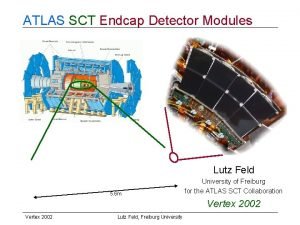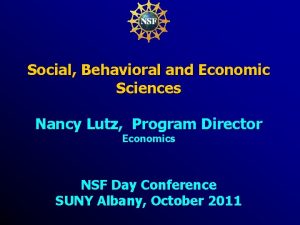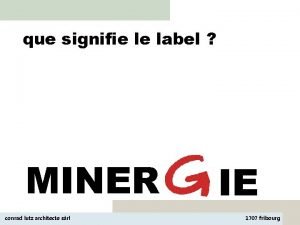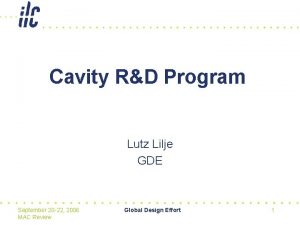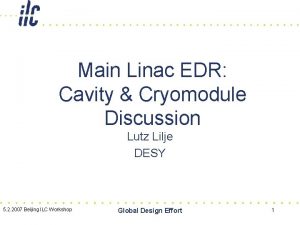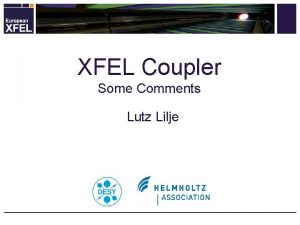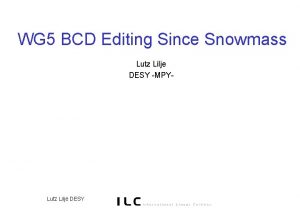S 0S 1 Next Steps Lutz Lilje GDE















- Slides: 15

S 0/S 1 Next Steps Lutz Lilje GDE ILC PM Meeting S 0 Webex 8. 10. 2007 Global Design Effort 1

Status • Field emission has been reduced – This is good news – Monitoring the three approaches (Ethanol, Ultrasound or Fresh EP) needed • Is there a significant advantage of one over the other? • Data set for Fresh EP on multi-cells small • Still rather large gradient differences are observed due to thermal breakdowns – Needs improved understanding of the nature of these breakdowns • E. g. some of the very low gradient breakdowns have been tracked to the equator region • At higher gradients this is not yet obvious • Need improved diagnostics – High-resolution temperature maps and high resolution optical inspection – There is a broad consensus on this in the SCRF community • See recent TTC Meeting at DESY ILC PM Meeting S 0 Webex 8. 10. 2007 Global Design Effort 2

DESY 4 th: Field Emission Analysis ILC PM Meeting S 0 Webex 8. 10. 2007 Global Design Effort 3

Field Emission Monitoring and Data Comparison for Multi-cell Data • A systematic first study on single- and nine-cells has shown that field emission could be reduced by three different approaches: – Ethanol Rinse, Degrease and Flash EP. • To add further credibility to the data a continuous monitoring of field emission properties for multi-cells is needed. • This will allow establishing the superiority of the proposed rinses and eventually make a choice for a baseline process. • This should be done in parallel to every test on nine-cells and therefore does not necessitate additional testing to first order. • Tasks – Production-like efforts in all three regions – Monitor tests esp. for field emission and compare results ILC PM Meeting S 0 Webex 8. 10. 2007 Global Design Effort 4

Variability due to Thermal Breakdown • General tasks – Improvement of diagnostic tools and the standard process – Initial tests to demonstrate the usefulness of these two systems on single cells should be done. • This calibration should be the first step and focus on the three rinsing methods mentioned already. – The single-cells will be insufficient for being the primary study tool on the standard processes, as • they show a different (namely smaller) spread in quenches • they are fabricated not in the same place as multi-cells • the surface preparation is simpler e. g. they typically do not need similar processing times • • After first tests on single-cells, the diagnostics should be applied to as many multi-cell cavities as possible. Tasks – Development and Application of high-resolution t-mapping and optical inspection systems – Use a set of single-cells cavities to ‘calibrate’ the systems mentioned above • A detailed analysis of quench locations is needed to check e. g. whether the weld affected zone shows breakdowns more often than other areas (Cavity WP 2. 3) – Use the systems on as many multi-cells as possible e. g. from the ‘production-like’ efforts (Cavity WPs 1. 2, 1. 3) ILC PM Meeting S 0 Webex 8. 10. 2007 Global Design Effort 5

High-Resolution Temperature Mapping Temperature mapping is a very important tool to understand the loss mechanisms in superconducting cavities. Loss mechanisms have typical signatures: -local heating for local defects, multipacting and field emission - global heating like in the case of high field enhanced surface resistance ILC PM Meeting S 0 Webex 8. 10. 2007 Global Design Effort 6

High-Resolution Optical Inspection ILC PM Meeting S 0 Webex 8. 10. 2007 Global Design Effort 7

ILC PM Meeting S 0 Webex 8. 10. 2007 Global Design Effort 8

AC 74: hot spot 1 95° 100μm Cell #4 1 mm ILC PM Meeting S 0 Webex 8. 10. 2007 Global Design Effort 9

AC 74: iris between cell#1 and #2 100μm θ=296° 100μm θ=298° 100μm θ=302° 1 mm ILC PM Meeting S 0 Webex 8. 10. 2007 Global Design Effort 10

Understanding Variability: Use of Alternatives • Data on alternative concepts needs to be accumulated (e. g. large grain material). – Use existing cavities with improved diagnostics • This allows crosschecking certain theories concerning the nature of thermal breakdowns. – Residues in grain boundaries – Defects in the weld heat affected zone – etc. • The alternatives should concentrate on the most attractive options – especially large-grain ILC PM Meeting S 0 Webex 8. 10. 2007 Global Design Effort 11

Variability due to Breakdown: Large-grain material • Large grain material has been developed as a cost saving option. – Further development on the optimum preparation process needs to be done. The data to date is not conclusive. – While JLab single-cell data suggests that etching is marginally sufficient to achieve ILC gradients, at DESY electropolishing shows a clear advantage over BCP in terms of gradient. • The surface of large-grain cavities can serve as a simpler system than the more complex fine-grain surfaces. This is certainly even more true for single-crystal cavities. Some theories claim that grain boundaries can lead to pre-mature breakdown due to either impurities or surface irregularities. • Tasks – (Demonstration of cost advantage) – not really S 0 – A study with t-mapping and optical inspection is needed on large-grain (or single-crystal) single-cells comparing the two surface treatments: EP and BCP – Development of large-grain multi-cells ILC PM Meeting S 0 Webex 8. 10. 2007 Global Design Effort 12

Variability due to Breakdown: Seamless cavities • A comparison of seamless cavities with welded cavities needs to be done to exclude the welding area and its surrounding as being problematic. • Tasks – A study with t-mapping and optical inspection is needed on a few electropolished single-cells of standard and weldless type ILC PM Meeting S 0 Webex 8. 10. 2007 Global Design Effort 13

Variability due to Breakdown: Vertical EP • Vertical EP on multi-cells can possibly straightforwardly used for the Flash EP (Fresh EP, Micro EP) a la K. Saito and be combined with temperature mapping. – Increase the experience with multi-cells • Task – Test several multi-cells with T-map after vertical Flash EP ILC PM Meeting S 0 Webex 8. 10. 2007 Global Design Effort 14

Proposal for Goals/Milestones • • The basic R&D goals for S 0 have not changed. The timescale has changed. End of 2008: – need to enhance temperature map (or similar) capacity worldwide – need to enhance high-res optical inpsection capacity woorldwide – use welded single-cells to 'calibrate' these two methods for mapping and inspection – use tight-loop to set up preparation facilities (ANL, KEK) – cost advantage large grain evaluation – continue production-like effort • 10 cavities Europe • 6+ cavities US • y cavities KEK • Mid of 2009 – large-grain detailed study after EP and BCP – comparison seamless with welded – Flash EP on multi-cells in Cornell (and KEK? ) • TDP 1: technical feasibility by 2010 – Gradient (S 0) in progress to reach 35 MV/m w/ yield 50 % • TDP 2: technical credibility by 2012 – Gradient (S 0) to reach 35 MV/m w/ yield 90 % ILC PM Meeting S 0 Webex 8. 10. 2007 Global Design Effort 15
 X.next = x.next.next
X.next = x.next.next Python next steps
Python next steps Python next steps
Python next steps Brigance transition skills inventory
Brigance transition skills inventory Next steps with academic conversations
Next steps with academic conversations Macmillan next steps
Macmillan next steps Next steps with academic conversations
Next steps with academic conversations Gerhard roth willensfreiheit ist eine illusion plato schema
Gerhard roth willensfreiheit ist eine illusion plato schema Lutz mail depot
Lutz mail depot Lutz prep lottery
Lutz prep lottery Lutz donnerhacke
Lutz donnerhacke Atlas sct
Atlas sct Nancy lutz
Nancy lutz Xyl lutz
Xyl lutz Lutz besser traumatische zange
Lutz besser traumatische zange Conrad lutz
Conrad lutz











